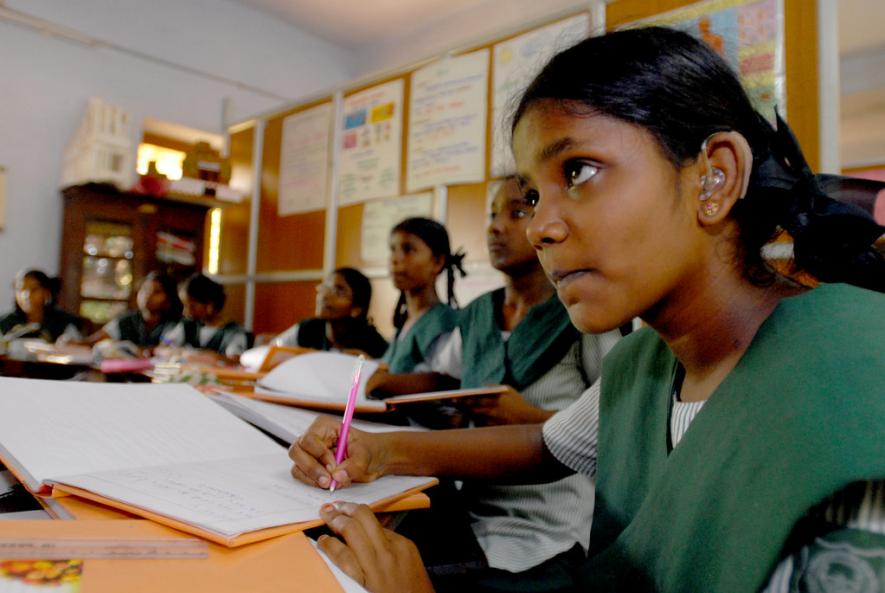NEP 2020: Path Breaking Policy or the Path to Destruction?

History shows that no policy document in India should ever be taken at face value. There is always an essence to such a document – the operational part which determines the actual outcomes it will produce – which has to be sifted out from the clutter of lofty objectives and catch phrases, put in to mask it. The National Education Policy 2020 adopted recently by the Union Cabinet is no exception, particularly when we keep in mind the nature of the regime that has produced it. The NEP has neither dropped suddenly from thin air, nor is it an isolated policy.
The singular defining feature of the trajectory of Indian education over the past several years has been a rampant process of privatisation of the sector, and a steep relative decline of its public component. At least 45% – if not more – of school enrolment in India is already in private schools. In higher education, the private sector dominance is greater, and increasing. About 45.2% of college enrolment in India is now in private unaided colleges, and another 21.2% is in private aided institutions.
It becomes even starker when we look at professional courses – where the fully private sector accounts for 72.5% of undergraduate, and 60.6% of post-graduate enrolment. The picture in universities, where public institution dominance is the greatest and lasted the longest, is also changing quite rapidly. Between 2014-15 and 2018-19, private universities have accounted for a whopping 55% of the increase in university enrolment. An additional 33% of the increase has been in public open universities, rather than in regular ones. Per capita expenditure by households on education services alone has also increased by over 50% over the same period, on the back of an already rising trend from before, including on account of rising fees, even in public institutions.
The evidence of the movement of the education system in India – in the direction of becoming more privatised and costlier – is thus clear and unambiguous. If an education policy formulated in this background does not choose to foreground this as a negative trend that needs to be pushed back, it means something. You know then that the real emphasis in the following extract from the last in a list of over twenty ‘fundamental principles’ of NEP 2020 is actually on the second part of the sentence, rather than the one in bold.
“...substantial investment in a strong, vibrant public education system as well as the encouragement and facilitation of true philanthropic private and community participation.” (NEP 2020, pp. 6).
The NEP 2020 has had to grudgingly concede the reality of rampant commercialisation of both school and higher education. Its proposed solution, however, is tweaking the regulatory regime to discourage commercialisation, but actively encourage “public-spirited private/philanthropic” institutions! Indeed, it repeatedly emphasises that both the public and private components of the system must be treated equally, as they have a common goal of quality education. In the process, it glossed over the fact that all the expansion of privatisation and commercial interests in education has been precisely through the proliferation of supposedly ‘not for profit’ institutions.
Privatisation of Indian education has been an integral element of a larger economic process of ‘liberalisation’ and ‘globalisation’; in which inequalities in the distribution of income and wealth have become increasingly skewed over time. This has increased the distance between the top ten percent of the population and the rest of India’s citizens. While the former has monopolised all the gains of growth produced by the labour of the rest, the majority of the Indian people have been struggling with the endemic problems of mass unemployment, underemployment and stagnating or declining returns to work. Increasingly, costly education has accentuated inequality in two ways. It has shut out access for those unable to pay, and also worked like a regressive system of taxation. The latter is because alongside the middle-class aspirations for the relatively small number of high paying white-collar jobs available in India and abroad, there has also been the growing aspiration for social and economic mobility among the more disadvantaged sections of Indian society. Both have led to an increasing social demand for education that has been exploited by the private sector in the absence of adequate public investment in the sphere.
While the NEP 2020 reiterates a commitment to the decades-old but never fulfilled goal of public spending at six percent of GDP, there are no concrete proposals in it about how the failure of so many decades will now be rectified, given that the tax-GDP ratio remains stuck at a very low level. It refuses to suggest that those who have profited immensely from squeezing out the maximum from the process of investing, including in education services, should be taxed adequately to finance stepping up of public investment in education. Instead, it places its hopes that profiteers will voluntarily give back to whom they have taken from, by philanthropic investment of their profits in education – no wonder then that the tag of being an ‘institution of eminence’ was given to a non-existent entity in anticipation some time ago. Further, NEP 2020 is replete with ‘initiatives’ about ‘expanding’ access in ways which would be cheap for the exchequer. Some examples of this being: placing the burden of pre-school “Early Child Care and Education” on Anganwadi workers, who would be trained for that purpose through online courses so that they can “acquire ECCE qualifications with minimal disruption to their current work”; ‘rationalization’ and ‘consolidation’ to wed out what are termed as “economically suboptimal” schools; or increasing the Gross Enrolment Ratio in higher education to 50% through the use of digital technologies and distance learning.
The conversion of education into a profit-making activity and the curtailment of public funding have also been mutually related consequences of the increasing capture of policy-making by beneficiaries of rising inequality. Fiscal restraint – not taxing too much nor spending too much – has had both a cause and effect relationship with this process. These have a similarly two-sided relationship with the undermining of India’s secular democracy currently under way – such a capture itself undermines democracy but also reinforces itself by hollowing out that democracy. After all, the increasing inequality and capture also creates the objective basis for a major challenge that could reflect itself through the ballot, and the exercise of nominally guaranteed constitutional freedoms and rights. The poisonous communalisation of Indian society and the reconstruction of Indian nationalism have been the ideological instruments of thwarting any such challenge and creating the cover for an increasingly aggressive authoritarianism.
As the fountainhead of these trends in India’s political system, the current regime ruling India has an interest in ensuring that the education system serves as its instrument. It also has to extinguish any possibility of the country having a publicly-funded mass education system that promotes ‘dangerous ideas’ of equity, freedom and justice. Partly, the process of privatisation of education itself represents a marriage between this interest and that of profiteering. An additional important element is the assault on particularly public higher education, that has involved throwing the might of state power against universities, students, faculty and demonisation of their protests. This background gives meaning – along with the noticeable omission of several hundred years of Indian history in it, to the underlying intentions behind the following additional fundamental guiding principle of NEP 2020 and the measures for putting it into effect:
“a rootedness and pride in India, and its rich, diverse, ancient and modern culture and knowledge systems and traditions.” (NEP 2020, pp. 6)
The NEP 2020, of course, does pay in its guiding principles obeisance to “emphasis on conceptual understanding”, promotion of “creativity and critical thinking”, and encouraging “ethics and human & Constitutional values like empathy, respect for others, cleanliness, courtesy, democratic spirit, spirit of service, respect for public property, scientific temper, liberty, responsibility, pluralism, equality, and justice”. Some of this is simply customary lip-service to these ideals, and the hypocrisy in it can be gauged from the actual record of respect that the Government has displayed for these ideals. In part, however, it also reflects an underlying framework, so deeply-tied with a profit-led economic trajectory, in which modernisation of the country is wholly and solely reduced to the question of technology and its development. NEP 2020 is based on a conception that the “world is undergoing rapid changes in the knowledge landscape” in which “many unskilled jobs worldwide may be taken over by machines” and there will be “the need for a skilled workforce … with multidisciplinary abilities”. The challenge in its view then is for “the education of India to lead the country into the 21st century and the fourth industrial revolution” and “thereby making India a global knowledge superpower”. Of course, these so-called highly ‘creative’ jobs will not be available to most except a select few – so for the rest vocational training has been thrown in by the NEP 2020 as the answer.
In drawing inspiration from ‘ancient’ Indian knowledge and tradition to nurse fantastic ambitions of a glorious future where India would be a global technological leader, NEP 2020 spins a tale full of contradictions that might sound pleasing to some. This serves the objective of preserving an exclusive character of education – in terms of which groups in society can get it and whose needs it serves. It, however, obscures the real educational challenges that spring from what in many ways is a specifically Indian present. The idea of encouraging the ‘internationalisation of Indian education’ reflects the same – it is all about serving the twin objective of widening the market for the private sector in the Indian education system and hoping to open up possibilities for a small stratum of Indian society to have a ‘global’ education.
The multiple, and at times conflicting objectives of privatisation of education, promotion of a Hindu nationalist world view, extinguishing any scope for education to play a role in promoting Indian society’s progressive transformation, and yet producing the skilled workforce that is believed to be the future requirement of a private capital led unequal development path – have shaped the kind of regulatory and governance structures that NEP 2020 makes a case for. This is a structure which promotes a more centralised, more top-down and ‘leadership’ driven and corporate-style structure of governance and regulation for Indian education, notwithstanding all the talk of placing teachers at the centre of the process.
‘Autonomy’ in this framework essentially boils down to giving a greater free reign to the profit motive in education, even while Government control over education, research and their content is being reinforced. The idea of introducing greater ‘flexibility’ for students may be in part connected to the idea about development of a skilled work-force with multi-disciplinary skills, but even that objective may be defeated by this menu-based choice model’s implications for the quality of education. More importantly, it is also about allowing private institutions to make a larger range of offerings to more effectively tap a differentiated market. It also serves the end of creating an illusion for those who cannot afford a full education, that they can complete it in instalments.
The immediate context of NEP 2020 is a deepening crisis of liberalisation and globalisation-based and a private capital-led development trajectory – with the pandemic only reinforcing an already downhill trend in the economy. In such a context, the quest for new areas of private investment is becoming more intense, the clamour for tax cuts and other sops for the corporate sector are becoming louder, the fiscal crisis of the state is becoming more aggravated, and the discontent of the people is becoming greater. This being the immediate background to NEP 2020, for the haste that the Government is exhibiting in pushing ahead with implementing “the first education policy of the 21st century”, there is no room to harbour any illusions about what are the real motives behind NEP 2020.
The writer is Professor of Economics, Jawaharlal Nehru University
Get the latest reports & analysis with people's perspective on Protests, movements & deep analytical videos, discussions of the current affairs in your Telegram app. Subscribe to NewsClick's Telegram channel & get Real-Time updates on stories, as they get published on our website.
























